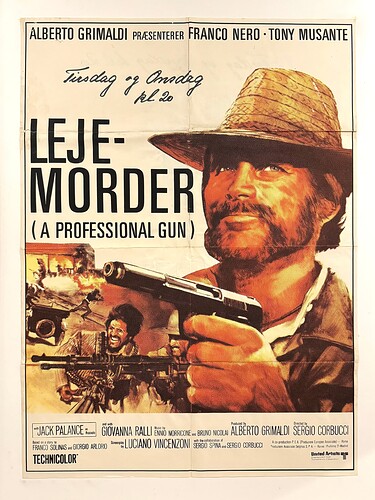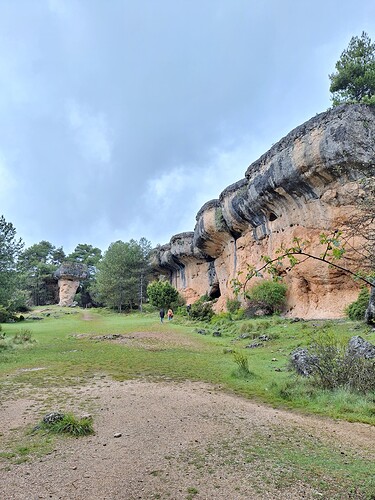I wonder if Kino Lorber will being doing a re-release of this one just like Navajo Joe… They probably will so I won’t buy one of the currently available blu-rays for this film just yet… I think it’s a bad time to buy a bluray of this film atm… best to wait until we get the KL re-release I’m suspecting will come eventually.
The UK, French or German discs are all similar
yeah but they’re super overpriced, plus i want that cool KL sleeve that their latest releases have for TM as well.
Stanton, can you please explain your statement, in your first reply to Diamond, “Leone added an encore to his “Dollars” films, but Corbucci really started the film again”? I think you mean that Leone added a coda to his films following the spectacular climax of each of his spaghetti westerns, whereas Corbucci merely ended his films with scenes that looked like new beginnings for his Italian westerns, with a new adventure with the same characters about to start anew. Am I correct?
Thank you for a most intelligent reply, blosserfred/Fred Blosser!
No, usually a western ends with a final duel, a final battle, and that’s the end of the film.
Leone added a sort of encore to his westerns, after the baddie is dead, the point where the audience doesn’t expect any more action, the hero has to fight a minor baddie in FoD and FaFDM, and that was new. Even in GBU Tuco has to put for a last time his head into a noose and in OuTW also something major happens after the final duel.
But in The Mercenary, even the audience trained to the Leone encores, might be more surprised. The arena shoot-out is not the expected and logical ending, and even more obviously so, as the flashback structure of the film is also closed with that scene. Instead the film starts again or goes on with more trouble for our two leads, and with another spectacular shoot-out. And only after that one the 2 leads have their final talk, the talk the audience must have expected shortly after the arena sequence.
And after that Corbucci begins to direct a real closing scene, with Paco riding away in the distance and music over it. This looks exactly like the last scene in dozens of westerns before, but suddenly instead of the end credits the camera movement shows men with rifles, and another shoot out follows. And only after that the film ends.
Most likely at that point a part of the audience were already leaving the theatre, in a book someone wrote that here indeed the audience had stood up, and sat down again.
I think probably nobody did such before in a genre film. This is as unusual as the ending of The Great Silence.
No other SW did such.
And with these multiple endings the film also changes from an optimistic end (I have a dream) to a pessimistic one (dream, but dream with your eyes open).
I love that about this movie. It just keeps on … giving ![]()
It also teaches you never to use weighted dice, unless you really like milk.
Yes, indeed, it’s one of those which still get better with every viewing.
Apart from it being pretty clever constructed, and having superb dialogues, the style of the film meanwhile really blows me away. It’s one of those rare films which give me a feeling of, that’s hard to describe, a kind of an inwardly fascination, I can feel these films, it’s more than just watching.
There is an incredible beauty in Il mercenario, and that comes not from the photography (which is also beautiful), but from the directing, the framing, the editing, and these things I can enjoy directly, I can feel them, and that happens not too often, but it’s what I’m searching for in films.
The Mercenary is a film for body and mind.
I should put that quote on the film’s page
I think stanton has see this film more times than I have Shoot the Living. I got some catching up to do
I believe the reason for Leone’s greater fame is that his films were far more successful, had a greater impact on the American western and broke new ground for all other genres, and, perhaps most of all, simply because he worked with Clint Eastwood–in fact, boosting him to major international stardom–and, since it is very well-known that Eastwood became a major international star through his Leone spaghetti westerns–Eastwood’s name being synonymous with the term “spaghetti western” since the “Dollars Trilogy”'s American release–Leone has gained great fame and interest worldwide through the reflected glory of Eastwood–and, to a lesser degree, through that of Charles Bronson, Henry Fonda, and Jason Robards, Jr., all of whom worked with Leone on the grandest spaghetti western of all, “Once Upon A Time In The West”, and through that of Eli Wallach–already a globally-renowned actor and lecturer on Method Acting long before doing “The Good, The Bad, And The Ugly” for Leone. Corbucci never worked with an American star as big–or who would become as big–as any of the above, except for Burt Reynolds in “Navajo Joe”, this film never enjoying the release Leone’s westerns did in America, and, as Sir Christopher Frayling, the world’s leading authority on spaghetti westerns and the director most associated with them, once stated, the only spaghetti westerns to be successful in America were those that were both directed by Leone, and which starred Eastwood. This statement has been disputed on this page, but it’s indisputable that the Leone/Eastwood collaborations enjoyed a spectacular American success that no other Italian and other European westerns ever did.
I still think I was on the same page with you, but thank you once more for a most informative–and enjoyable–reply!
A challenge for you! Change my point of view on this film.
The Mercenary is a revered film within the genre, and don’t get me wrong, I like the movie. It is a good movie. However, now that I have seen over 100 Spaghetti Westerns it no longer holds a place in my personal top 20. The reason being is that I have several issues with it:-
Issue 1 - It is inconsistent / lacks structure - the first half is frenetic. We bounce from scene to scene, as town after town is liberated by the revolutionaries, without much of a storyline holding it together. In the second half of the film Corbucci does develop the story and lets the film breathe in what appears to be a homage to Leone. He slows things right down for the gunfight in the bull ring. This scene, itself, is a recreation of the final showdown in For a Few Dollars More with Nero playing Eastwood’s role as referee whilst Musante (playing Van Cleef’s role) duels Palance (Volonte’s Indio). [As a complete aside Sollima paid Leone the same homage at the end of The Big Gundown, with Van Cleef refereeing the accused rapist Milian’s gun/knife fight with the real rapist.]. I do think the last 30 minutes of the movie are great, and rescue the film somewhat.
Issue 2 - It descends into silliness once too often - the film is intended to be a fun film with humour, which would be great, but occasionally (and for me that is too often) the film oversteps the line from funny to silly.
Issue 3 - Jack Palance’s character - as a protagonist Palance’s bewigged and camp Curly doesn’t, in my opinion, present much of a threat and adds to the sense of silliness. Compare this character to say the psychotic Indio in For a Few Dollars More or even the smart Bill San Antonio in God Forgives… I don’t!
Issue 4 - Franco Nero’s character - when Nero plays a taciturn, non-verbose character (e.g. Django, Keoma) I like his work. When he plays a “man about town”, cheeky chappy character (e.g. The Mercenary, Campaneros, Don’t Turn the Other Cheek or, even outside the genre, Day of the Cobra) he irritates me. I accept, this may just be a personal issue.
“Change your views, or we’ll send the boys round!” ![]()
Personally, I like ‘The Mercenary’, but I can also also appreciate your comments. It’s good to hear another amigo’s point of view…
I do like The Mercenary amigo. But I haven’t embraced it yet, to the extent that many clearly have. I like it, I don’t love it.
Sometimes, that’s the best view to have…because it shows you have an open mind…![]()
Happy viewing, amigo…
The Mercenary is one of my top five Spaghetti Westerns, though it used to rank much lower. It’s one of those films that gets better with each rewatch - the inverse of Companeros, which seemed stronger at first but it’s major flaws become increasingly apparent over time.
I can see where you’re coming from with your first criticism, @Ian - the film is roughly structured - but that’s actually something I’ve come to appreciate, it’s pacing makes it unpredictable and it feels like the film never wants to end. As for the silliness, I strongly disagree. It might be sillier than The Good, the Bad and the Ugly, but it’s no sillier than For a Few Dollars More. It’s satirical, but not comedic.

